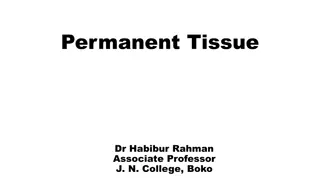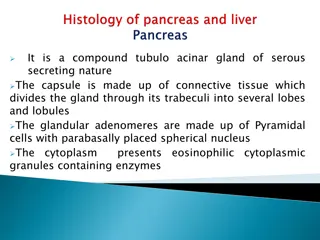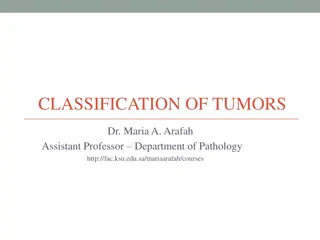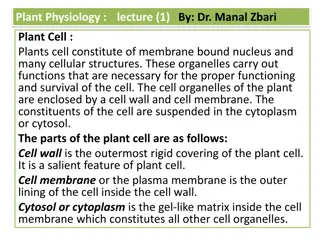Nursing Care for Ventilator-Associated Pneumonia (VAP)
Ventilator-Associated Pneumonia (VAP) is defined as lung parenchyma inflammation occurring 48 hours or more after endotracheal intubation and mechanical ventilation initiation. It is a common nosocomial infection in ICU patients, with significant morbidity and mortality rates. Etiology of VAP involv
2 views • 24 slides
Understanding Plant Permanent Tissues: Parenchyma, Collenchyma, Sclerenchyma
Plant permanent tissues, including parenchyma, collenchyma, and sclerenchyma, play crucial roles in the structure and support of plants. Parenchyma is a versatile tissue that aids in storage and rigidity, while collenchyma provides mechanical support and elasticity in growing plant parts. Sclerenchy
0 views • 31 slides
Transport in the Phloem: A Detailed Overview by Ashish Sharma, Ph.D.
The phloem plays a vital role in transporting sugars and organic materials throughout plants. This system involves various specialized cells like sieve elements, companion cells, parenchyma cells, and phloem fibers. Mature sieve elements lack certain organelles and have non-lignified cell walls, mak
7 views • 32 slides
Thyroid and Parathyroid Glands Histological Structure Overview
This detailed histological study covers the structure and function of the thyroid and parathyroid glands. It includes information on the stroma, parenchyma, follicular cells, parafollicular cells, and the microscopic structure of the parathyroid gland. The article also delves into the functions of v
0 views • 8 slides
Exploring the Wonders of Cinnamon Bark and Its Uses
Cinnamon bark, derived from Cinnamomum zeylanicum trees, is a revered spice known for its aromatic qualities. The powder showcases light brown or yellowish-brown color with a sweet taste. Microscopically, it contains phloem fibers, sclereids, and parenchyma fragments. This versatile ingredient serve
2 views • 8 slides
Structure and Function of a Serous Compound Tubulo-acinar Gland
A detailed description of a compound tubulo-acinar gland with serous-secreting nature is provided, highlighting its cellular composition, arrangement of ducts, and connective tissue organization. The glandular structure, including adenomeres, centroacinar cells, and myoepithelial cells, is discussed
0 views • 15 slides
Classification of Tumors: A Comprehensive Overview
Understanding the classification of tumors is crucial in the field of pathology. This detailed overview covers the definitions of neoplasia and tumors, the differentiation between benign and malignant tumors, nomenclature, and characteristics of various tumor types. It discusses the behaviors of ben
1 views • 34 slides
Understanding Plant Cell Physiology and Functions
Plant cells are the fundamental units of life in the Plantae kingdom, comprising various organelles like the nucleus, chloroplasts, and mitochondria. These cells perform essential functions such as photosynthesis, cellular respiration, and storage. Differentiated by their unique cell walls, chloropl
1 views • 24 slides







